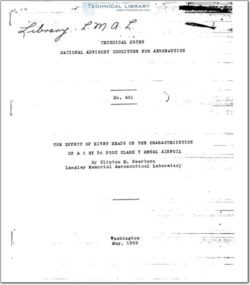naca-tn-461

- Version
- 233 Downloads
- 884.72 KB File Size
- 1 File Count
- April 23, 2016 Create Date
- April 23, 2016 Last Updated
National Advisory Committee for Aeronautics, Technical Notes - The Effect of Rivet Heads on the Characteristics of a 6 by 36 Foot Clark Y Metal Airfoil

An investigation was conducted in the N.A.C.A. full-
scale wind tunnel to determine the effects of exposed riv—
et heads on the aerodynamic characteristics of a metal~
covered 6 by 36 foot Clark Y airfoil. Lead punchings sim»
ulating 1/8- inch rivet heads were attached in full— span
rows at a pitch of 1 inch at various chord positions.
Tests were made at velocities varying from 40 to 120 miles
per hour to investigate the scale effect.
Rivets at the 5 per cent chord.position on the upper
surface of the airfoil produced the greatest increase in
drag for a single row. Nine rows of rivets on both sur-
faces, simulating rivet spacing of _multispar construction,
increased the drag coefficients by a constant amount at
velocities betWGen 100 and 130 miles per hour. Extrapola—
tion of the curves indicates that the same increase would
be obtained at speeds over 120 miles per hour. According—
ly, if rivets spaced the same as those on the test airfoil
were used on a Clark Y wing of 300 squarE'feet area and
operated at 200 miles per hour the drag would be increased
over that for the smooth wing by 55 pounds and the power
required would be increased by 29 horsepower. The effect
on the lift characteristics due to the rivets was found
to be negligible.
One of the most promising possibilities of improving
the performance of airplanes lies in the reduction of
drag. A recent airfoil investigation conducted in the
N.A.C.A. variable-density wind tunnel on full—span protue
berances (reference 1) and on short-span prctuberances,
including wing fittings (reference 2), shoWed that small
protuberances have an important effect on the aerodynamic
characteristics of an airfoil. This investigation was ex—
tended to include the determination of the effects caused
by exposed rivet heads of a type common to metal airplane
wing construction. The latter tests were conducted in
the full-scale wind tunnel on a 6 by 36 foot airfoil.
| File | Action |
|---|---|
| naca-tn-461 The Effect of Rivet Heads on the Characteristics of a 6 by 36 Foot Clark Y Metal Airfoil.pdf | Download |
Comment On This Post